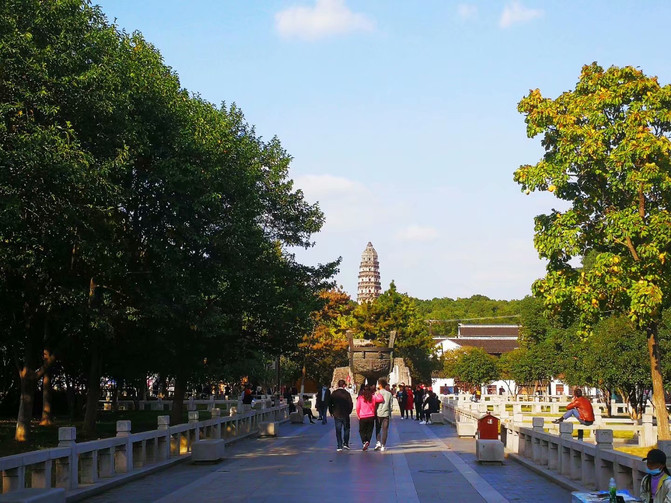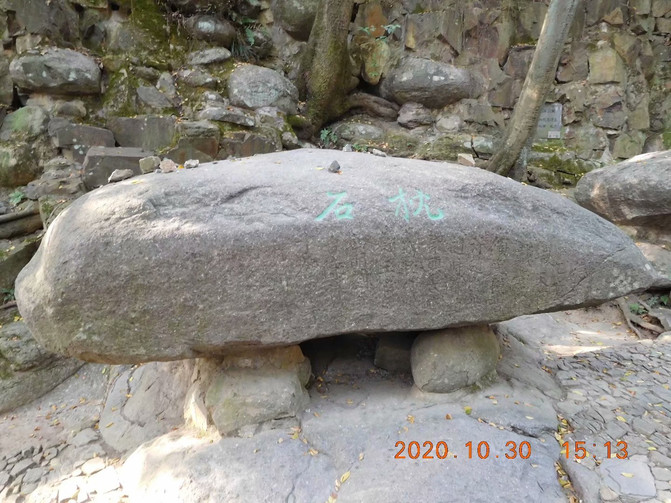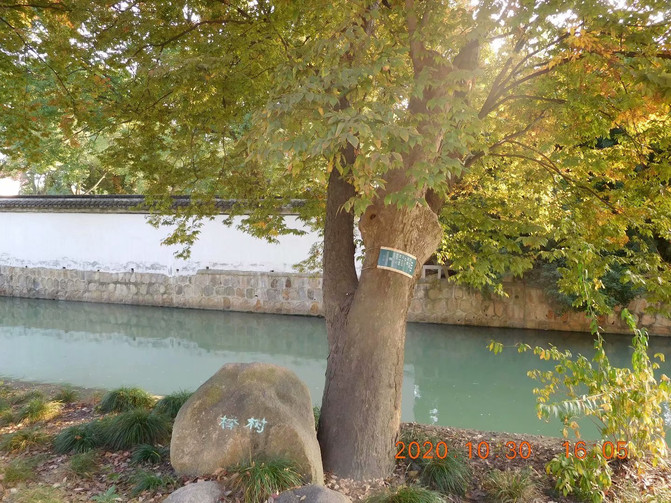[Gouqi Island Shanghai-Suzhou Tour] 6. Huqiu Mountain Jianchi supports the leaning tower, King Helu of Wu is safe today

[Gouqi Island Shanghai-Suzhou Tour] 6. Huqiu Mountain Jianchi supports the leaning tower, King Helu of Wu is safe today
On October 30, when you came out of the red Shajiabang Scenic Area, you came to Huqiu Mountain, a historical tour.
Suzhou Huqiu Mountain is a famous scenic spot with a long history of more than 2500 years. It is known as the "No. 1 scenic spot in Wuzhong". Su Dongpo, a great literary hero of the Song Dynasty, said "It would be a pity not to visit Tiger Hill when visiting Suzhou", making Tiger Hill a must-visit place for tourists to Suzhou and a symbol of the famous historical and cultural city of Suzhou. Su Dongpo's famous saying is the best slogan in Huqiu, so you have to check in.
Huqiu, formerly known as Haiyong Mountain, is recorded in the "Historical Records" that King Helu of Wu was buried here. It is said that three days after the burial, a "white tiger crouched on it", hence the name. Although Tiger Hill covers an area of only more than 300 acres and is only more than 30 meters high, it has the style of "the surface of the hills and valleys on the left of the river". It is surrounded by rocks and valleys, has thousands of scenery, and has the best of three unique, nine suitable and eighteen scenic spots. The most famous ones are the Yunyan Temple Pagoda and Sword Pond.
Standing under the majestic gate of the first pass in Wuzhong, my heart became solemn. Many stories will be interpreted one by one by the steps forward.


Entering the Tiger Hill Scenic Area, you will see a huge thousand-jin tripod in the distance, located in the middle of the road. The dark body of the cauldron bears the totem of a tiger. The eyes are full of rage, and the image is exaggerated and realistic, as if you can swallow a person alive with just one mouth. His three legs are strong and powerful, as thick as an adult's waist. The giant shape is intimidating.


Following the tour guide up the mountain and listening to the tour guide's explanation, on this short mountain road, there are Hanhan Well dug by Hanhan Monk Hanhan in the Eastern Jin Dynasty, a sword testing stone by King Helu of Wu, and a "pillow stone". What they talk about is about Tang Bohu, a popular scholar, resting here.

Everyone stopped next to an ancient well on the left side of the road. A well platform made of a huge stone more than half a meter high has the words Hanhan Spring engraved on it. The wellhead has been ground to be round and smooth, only enough to accommodate one person, but the probe can still see water at the bottom of the well. It is said that this well is a monk suffering from eye diseases. He rested here in the afternoon while carrying water. He dreamed that the spring was surging here, so he dug with a pole for forty-nine days, and the spring water gushed out. Monk Hanhan was very excited. After drinking the well water, his eyes suddenly lit up, so he named it after it to remember the water intake and not forget the person who dug the well.

Moving forward, I saw the sword-testing stone. A large stone cracked open in it, and the cracked section was straight and smooth. It is said that the King of Wu passed by here with the Moye Sword in his hand. Seeing that this stone was smooth and hard, he decided to use it to test the sword in his hand. So he waved his hand and hacked it, and the stone cracked open in it. It did not change after two thousand years of wind and sun. This crack is three fingers wide and more than one meter long. If closed, it will still be a complete stone.


Regarding this nodding stone, Song Yang Bei wrote in the poem "Thousands of People Sitting":
"The famous mountain on the sea is the Tiger Hill, and the relics of Shenggong remain today. Back then, it was said that thousands of people sat down, but I once saw the stone beside the rock nod."

We have arrived at the Sword Pond. There are three ways to explain the name of the Sword Pond:
First, when viewed from above, the sword pool looks like a flat sword.
Second, among He Lu's funeral objects were 3,000 Bian Zhu Yuchang swords.
Third, Qin Shihuang and Sun Quan both came here to dig swords, and the sword pool was dug by them.
It turns out that the Sword Pond is the opening of the legendary tomb of Helu. No wonder countless literati and scholars in history have visited this place and left many precious ink stains behind.


The four characters "Tiger Hill Sword Pool" were written by Yan Zhenqing, a famous calligrapher in the Tang Dynasty in my country. After he wrote these four characters, many years later, the word "Huqiu" gradually fell into oblivion. In the Ming Dynasty, Ma Zhijun, the prefect of Suzhou, ordered the famous stone carving master Zhang Zhongyu to reproduce and re-engrave the word "Huqiu".
However, it seems that future generations always feel that the word "tiger hill" is not as well written and beautiful as the word "sword pool", so there is the saying of "fake tiger hill and real sword pool."
"Fake Huqiu Real Sword Pond" has another meaning, which also implies the secret of Helu's tomb, because the steep cliffs on the east and west walls of the sword pond are naturally formed, while the back mountain of Huqiu is built with artificial soil. The purpose is to cover up the tomb of King Helu of Wu.


In the sword pool, fish are swimming. Legend has it that the pool is the tomb of King Helu of Wu. There are 3,000 swords hidden in the tomb, hence the name Sword Pool. In 1512, Tang Bohu and others discovered the tomb door because the pool water dried up. This tomb is under the Huqiu Pagoda. It has not been excavated yet for fear of affecting the 6000-ton tower body.



There is a "Kezhong Pavilion" next to the sword pool, and there is a Shuangjing Bridge (double bucket) on the bridge, which is dozens of meters high. Two holes were drilled in the stone slab in the bridge, known as the "double wells". Buckets can be put into the sword pool under the bridge to draw water. It is a unique well in the world! Afraid that tourists would slip down, X-shaped iron pieces were put on them.
The sword pool is mysterious and mysterious, and the wind valleys and cloud springs make people forget to leave.
The "Erxian Pavilion" was originally a building in the Song Dynasty and was rebuilt during the Jiaqing period of the Qing Dynasty. Looking around the pavilion, you can see that its carvings are very fine and vivid. There are two stone tablets in this pavilion, each engraved with two gods, one is Chen Tuan, and the other is Lu Dongbin.

Legend has it that one day these two great immortals were playing chess here. A woodcutter saw him, so he came over to watch them play chess. After watching a game of chess, he returned home, but no one knew him. Later, people guessed from his clothes that he was a man thousands of years ago. Therefore, there is a saying,"Immortals play chess, and the world has been thousands of years."
Walking further up from the sword pool, there were more people. When I looked up, a huge tower appeared in front of me. After taking a closer look, I was shocked. This tower was actually tilted! Falling down is terrible (every time I see a slightly sloping building, I am worried that it will fall down. Isn't it a bit alarmist), why are there so many people taking photos and playing in front of the tower? My mind went blank for three seconds before I realized that my worries were unnecessary.


The Tiger Hill Tower has seven floors and has a history of more than a thousand years. It is the second leaning tower in the world. It is called the Leaning Tower of Pisa in the East. Each floor is so exquisitely built, simple and magnificent, with a towering tower and several green trees. Born in the cracks of the brick tower, it is amazing. On the eaves of the tower, there is dense grass, which has become part of the tower view. Tiger Hill is a witness to Suzhou's 2,500-year history. The Tiger Hill Pagoda standing high on the top of the mountain has become a symbol of Suzhou and a symbol of ancient Suzhou. In my heart, I once again admire the architectural art of the ancient people of our country.
The tour guide said that walking around the Tiger Hill Pagoda three times could ensure safety and health, so everyone did. Some group members were more devout, folded their hands together in front of their chests, and silently chanted as they walked.
The autumn atmosphere of Tiger Hill spreads out from the scenery and small flowers in the garden.





Everything is revived, and the world spurts out green and a little yellow from every grass and tree.






The cruise ships in Huqiu all show you the charm of the small bridges and flowing water in the Jiangnan water town.






Tiger Hill is full of legends. When you walk into Tiger Hill, look back at history, listen to the thoughts and wisdom of the sages, marvel at the superb skills of ancient Chinese craftsmen, and look at the monuments left behind by the ancients. You seem to be able to hear the sound of history. Perhaps this is the inspiration and significance that scenic spots and historic sites bring to us.
(2073 2020/11/20)
Previous Article:Go to Yinshan Lake to see the exhibition: Jiangnan in ink painting, poetic fireworks in the world
Next Article:There is heaven above, Suzhou and Hangzhou below
